Evaluating the Success of the United Nations: An International Study
VerifiedAdded on 2023/04/22
|6
|1500
|499
Essay
AI Summary
This essay provides a comprehensive analysis of the United Nations, examining its structure, aims, and historical context. It begins with an introduction that outlines the UN's formation, member states, the role of superpowers, and its historical background. The main body delves into the UN's objectives, its various organs, and its efforts in maintaining peace, resolving conflicts, and addressing global issues like poverty and climate change. The essay evaluates both the successes, such as preventing major wars and providing aid, and failures, such as the ongoing Syrian crisis and the issue of terrorism. The conclusion summarizes the UN's effectiveness, suggesting measures to enhance its performance, such as establishing subsidiary committees and active intervention in crisis situations. The essay highlights the UN's significance as an international organization and its impact on global affairs. This assignment, contributed by a student, is available on Desklib, a platform offering AI-based study tools.
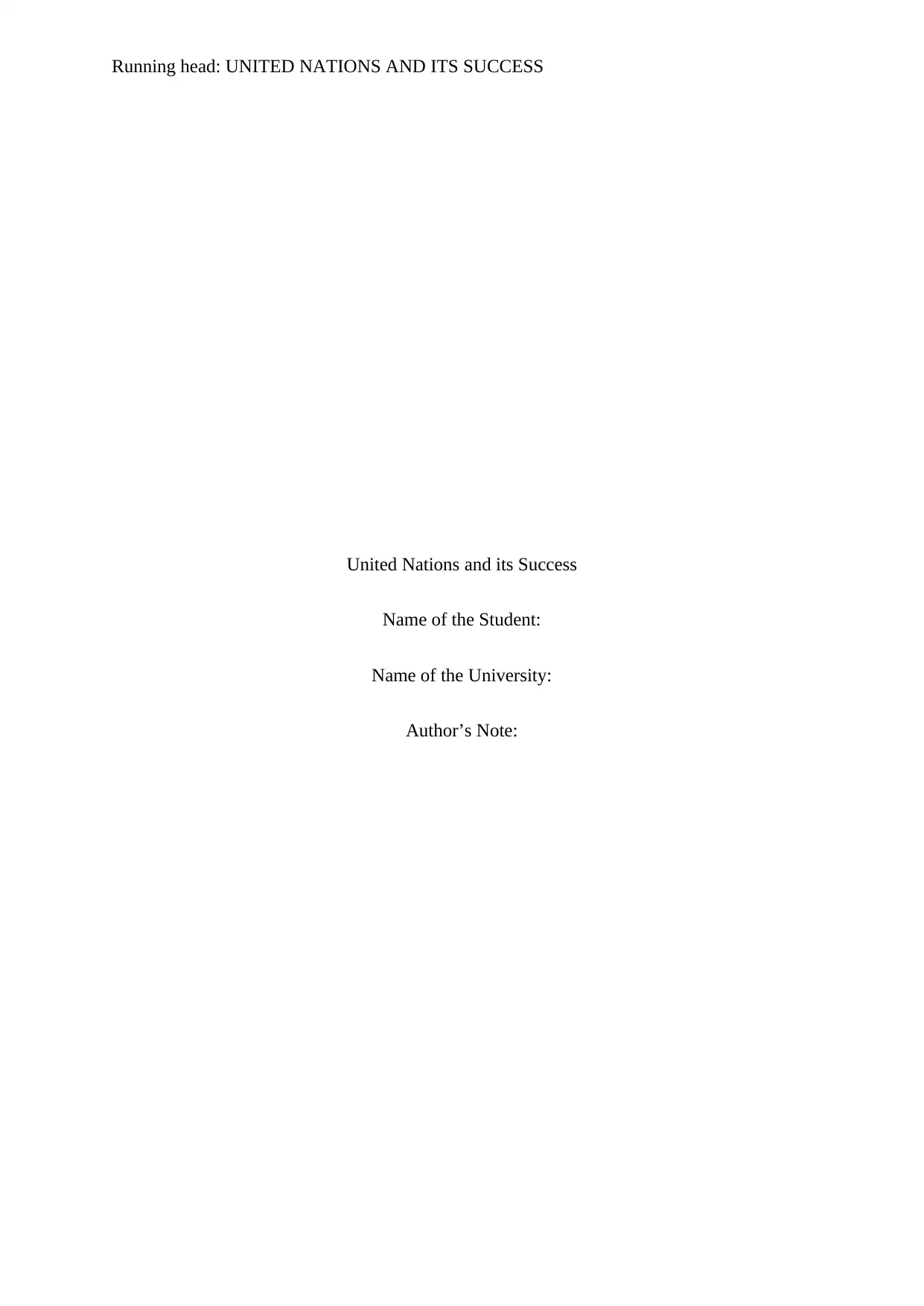
Running head: UNITED NATIONS AND ITS SUCCESS
United Nations and its Success
Name of the Student:
Name of the University:
Author’s Note:
United Nations and its Success
Name of the Student:
Name of the University:
Author’s Note:
Paraphrase This Document
Need a fresh take? Get an instant paraphrase of this document with our AI Paraphraser
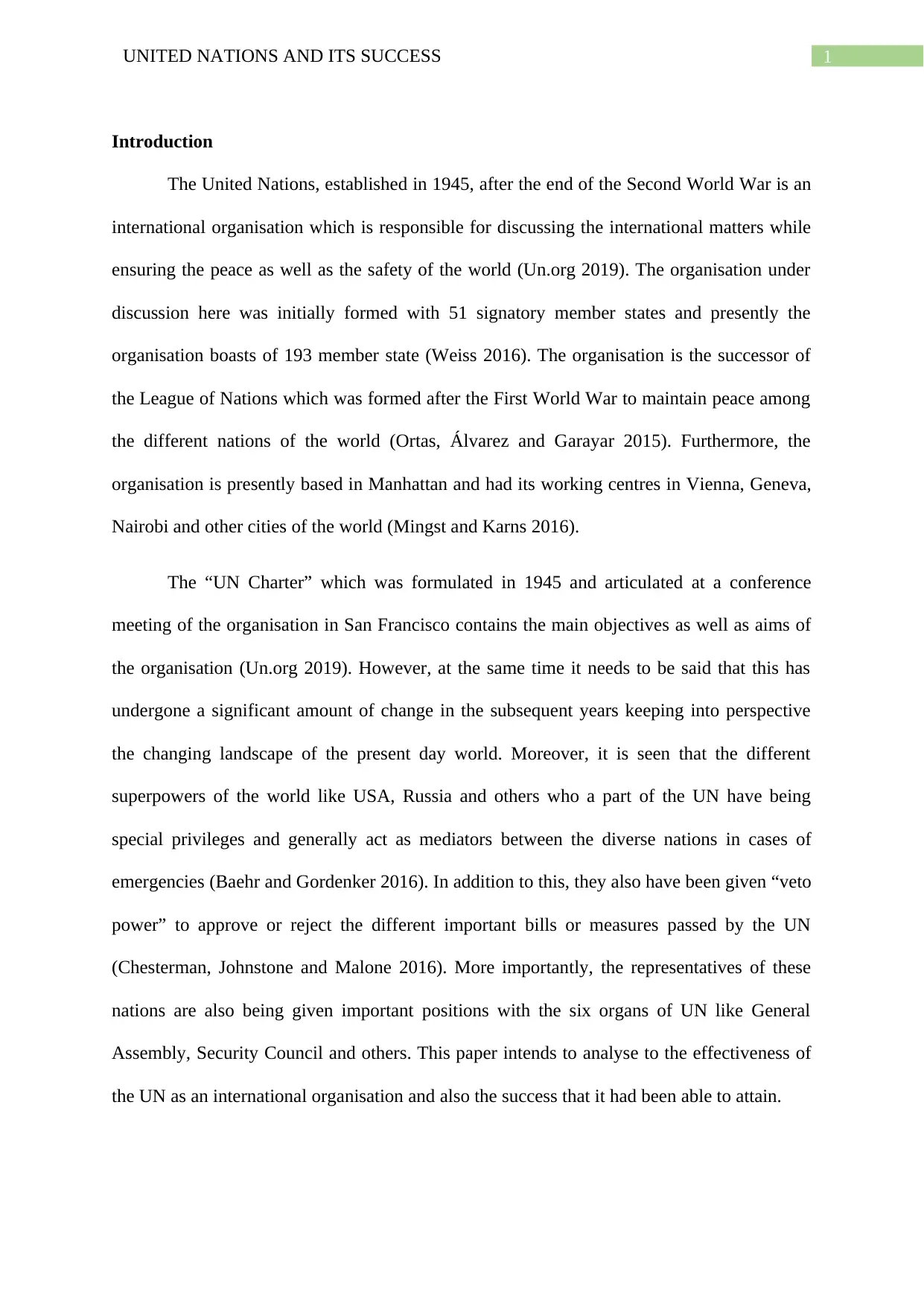
1UNITED NATIONS AND ITS SUCCESS
Introduction
The United Nations, established in 1945, after the end of the Second World War is an
international organisation which is responsible for discussing the international matters while
ensuring the peace as well as the safety of the world (Un.org 2019). The organisation under
discussion here was initially formed with 51 signatory member states and presently the
organisation boasts of 193 member state (Weiss 2016). The organisation is the successor of
the League of Nations which was formed after the First World War to maintain peace among
the different nations of the world (Ortas, Álvarez and Garayar 2015). Furthermore, the
organisation is presently based in Manhattan and had its working centres in Vienna, Geneva,
Nairobi and other cities of the world (Mingst and Karns 2016).
The “UN Charter” which was formulated in 1945 and articulated at a conference
meeting of the organisation in San Francisco contains the main objectives as well as aims of
the organisation (Un.org 2019). However, at the same time it needs to be said that this has
undergone a significant amount of change in the subsequent years keeping into perspective
the changing landscape of the present day world. Moreover, it is seen that the different
superpowers of the world like USA, Russia and others who a part of the UN have being
special privileges and generally act as mediators between the diverse nations in cases of
emergencies (Baehr and Gordenker 2016). In addition to this, they also have been given “veto
power” to approve or reject the different important bills or measures passed by the UN
(Chesterman, Johnstone and Malone 2016). More importantly, the representatives of these
nations are also being given important positions with the six organs of UN like General
Assembly, Security Council and others. This paper intends to analyse to the effectiveness of
the UN as an international organisation and also the success that it had been able to attain.
Introduction
The United Nations, established in 1945, after the end of the Second World War is an
international organisation which is responsible for discussing the international matters while
ensuring the peace as well as the safety of the world (Un.org 2019). The organisation under
discussion here was initially formed with 51 signatory member states and presently the
organisation boasts of 193 member state (Weiss 2016). The organisation is the successor of
the League of Nations which was formed after the First World War to maintain peace among
the different nations of the world (Ortas, Álvarez and Garayar 2015). Furthermore, the
organisation is presently based in Manhattan and had its working centres in Vienna, Geneva,
Nairobi and other cities of the world (Mingst and Karns 2016).
The “UN Charter” which was formulated in 1945 and articulated at a conference
meeting of the organisation in San Francisco contains the main objectives as well as aims of
the organisation (Un.org 2019). However, at the same time it needs to be said that this has
undergone a significant amount of change in the subsequent years keeping into perspective
the changing landscape of the present day world. Moreover, it is seen that the different
superpowers of the world like USA, Russia and others who a part of the UN have being
special privileges and generally act as mediators between the diverse nations in cases of
emergencies (Baehr and Gordenker 2016). In addition to this, they also have been given “veto
power” to approve or reject the different important bills or measures passed by the UN
(Chesterman, Johnstone and Malone 2016). More importantly, the representatives of these
nations are also being given important positions with the six organs of UN like General
Assembly, Security Council and others. This paper intends to analyse to the effectiveness of
the UN as an international organisation and also the success that it had been able to attain.
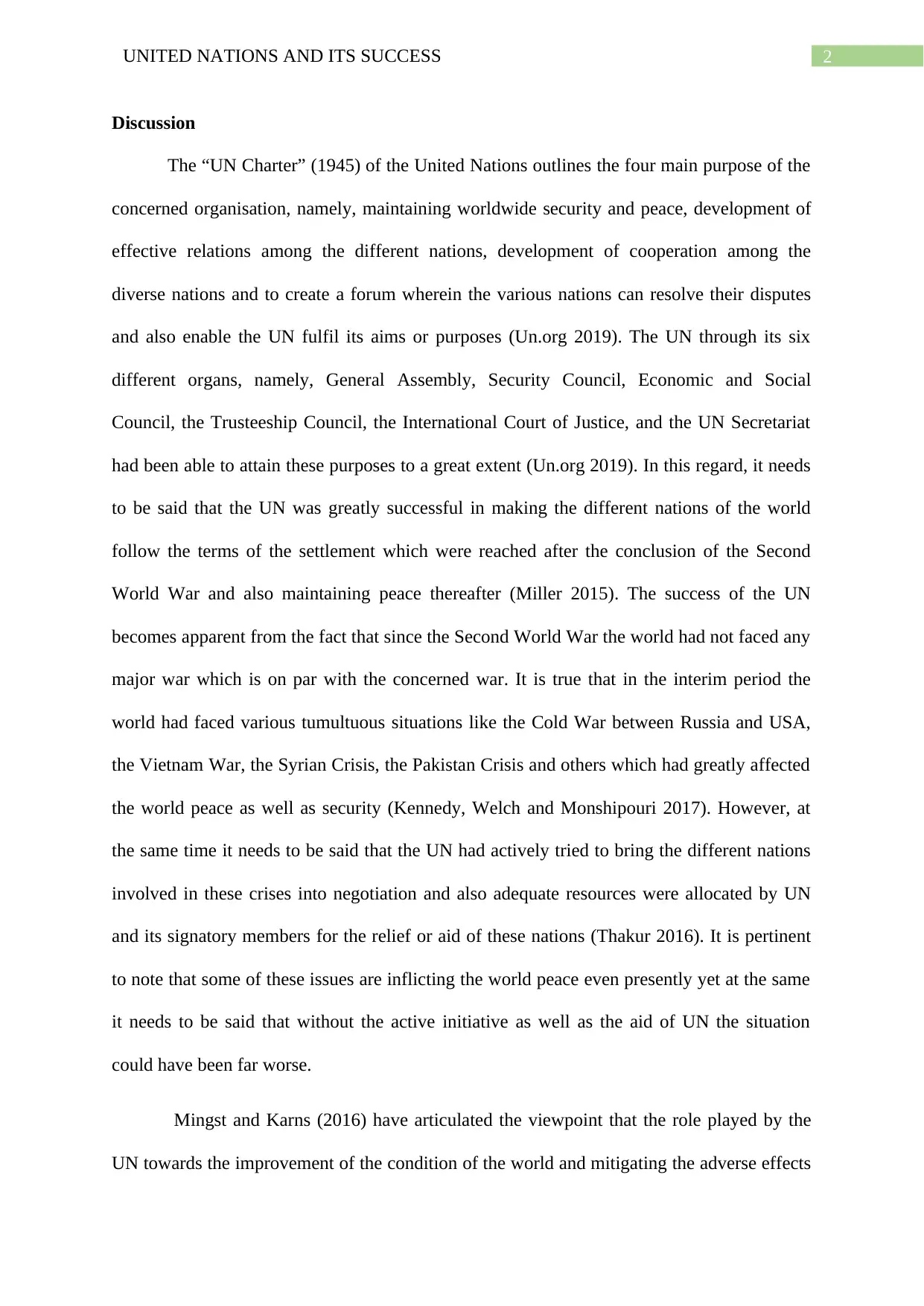
2UNITED NATIONS AND ITS SUCCESS
Discussion
The “UN Charter” (1945) of the United Nations outlines the four main purpose of the
concerned organisation, namely, maintaining worldwide security and peace, development of
effective relations among the different nations, development of cooperation among the
diverse nations and to create a forum wherein the various nations can resolve their disputes
and also enable the UN fulfil its aims or purposes (Un.org 2019). The UN through its six
different organs, namely, General Assembly, Security Council, Economic and Social
Council, the Trusteeship Council, the International Court of Justice, and the UN Secretariat
had been able to attain these purposes to a great extent (Un.org 2019). In this regard, it needs
to be said that the UN was greatly successful in making the different nations of the world
follow the terms of the settlement which were reached after the conclusion of the Second
World War and also maintaining peace thereafter (Miller 2015). The success of the UN
becomes apparent from the fact that since the Second World War the world had not faced any
major war which is on par with the concerned war. It is true that in the interim period the
world had faced various tumultuous situations like the Cold War between Russia and USA,
the Vietnam War, the Syrian Crisis, the Pakistan Crisis and others which had greatly affected
the world peace as well as security (Kennedy, Welch and Monshipouri 2017). However, at
the same time it needs to be said that the UN had actively tried to bring the different nations
involved in these crises into negotiation and also adequate resources were allocated by UN
and its signatory members for the relief or aid of these nations (Thakur 2016). It is pertinent
to note that some of these issues are inflicting the world peace even presently yet at the same
it needs to be said that without the active initiative as well as the aid of UN the situation
could have been far worse.
Mingst and Karns (2016) have articulated the viewpoint that the role played by the
UN towards the improvement of the condition of the world and mitigating the adverse effects
Discussion
The “UN Charter” (1945) of the United Nations outlines the four main purpose of the
concerned organisation, namely, maintaining worldwide security and peace, development of
effective relations among the different nations, development of cooperation among the
diverse nations and to create a forum wherein the various nations can resolve their disputes
and also enable the UN fulfil its aims or purposes (Un.org 2019). The UN through its six
different organs, namely, General Assembly, Security Council, Economic and Social
Council, the Trusteeship Council, the International Court of Justice, and the UN Secretariat
had been able to attain these purposes to a great extent (Un.org 2019). In this regard, it needs
to be said that the UN was greatly successful in making the different nations of the world
follow the terms of the settlement which were reached after the conclusion of the Second
World War and also maintaining peace thereafter (Miller 2015). The success of the UN
becomes apparent from the fact that since the Second World War the world had not faced any
major war which is on par with the concerned war. It is true that in the interim period the
world had faced various tumultuous situations like the Cold War between Russia and USA,
the Vietnam War, the Syrian Crisis, the Pakistan Crisis and others which had greatly affected
the world peace as well as security (Kennedy, Welch and Monshipouri 2017). However, at
the same time it needs to be said that the UN had actively tried to bring the different nations
involved in these crises into negotiation and also adequate resources were allocated by UN
and its signatory members for the relief or aid of these nations (Thakur 2016). It is pertinent
to note that some of these issues are inflicting the world peace even presently yet at the same
it needs to be said that without the active initiative as well as the aid of UN the situation
could have been far worse.
Mingst and Karns (2016) have articulated the viewpoint that the role played by the
UN towards the improvement of the condition of the world and mitigating the adverse effects
⊘ This is a preview!⊘
Do you want full access?
Subscribe today to unlock all pages.

Trusted by 1+ million students worldwide
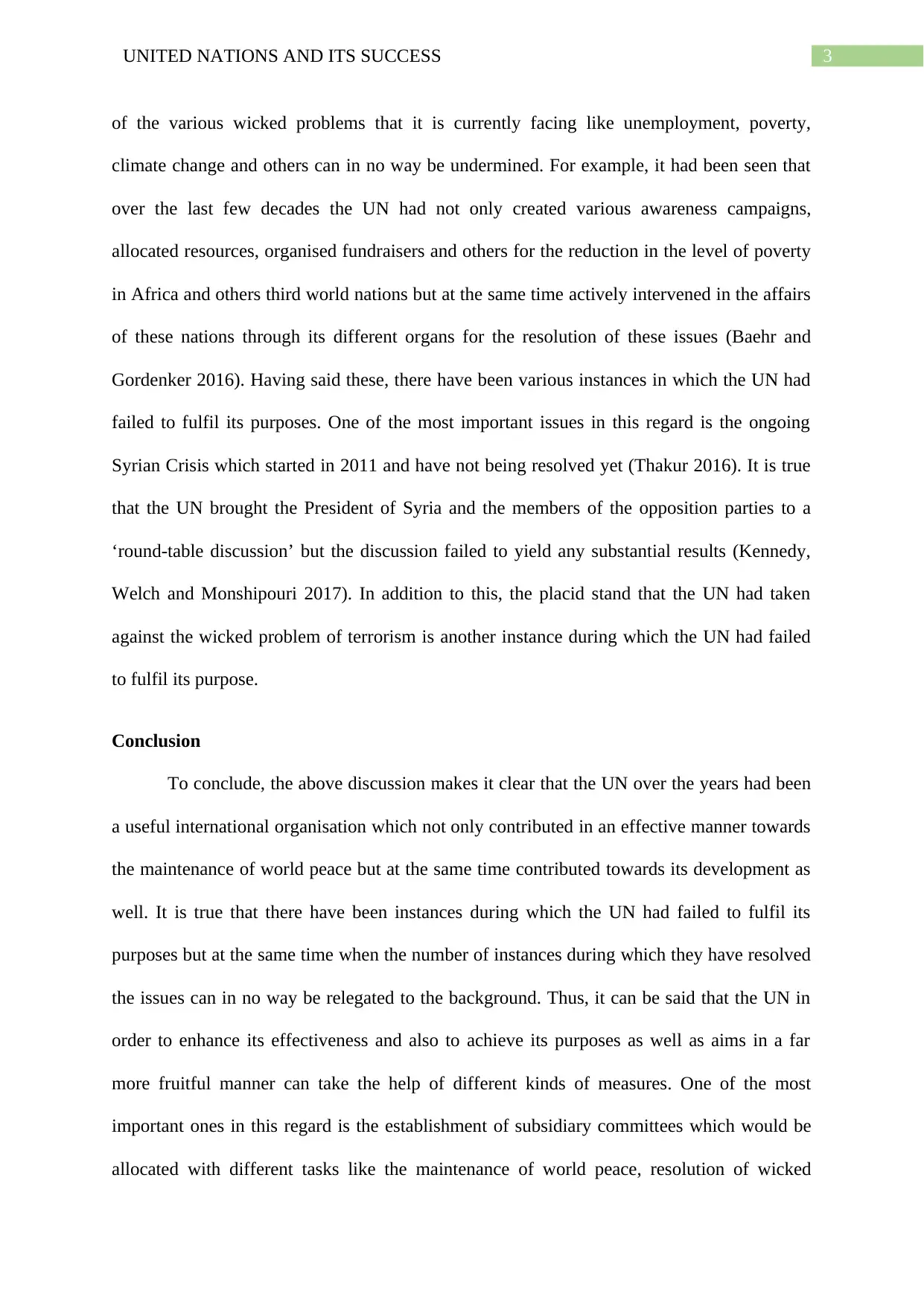
3UNITED NATIONS AND ITS SUCCESS
of the various wicked problems that it is currently facing like unemployment, poverty,
climate change and others can in no way be undermined. For example, it had been seen that
over the last few decades the UN had not only created various awareness campaigns,
allocated resources, organised fundraisers and others for the reduction in the level of poverty
in Africa and others third world nations but at the same time actively intervened in the affairs
of these nations through its different organs for the resolution of these issues (Baehr and
Gordenker 2016). Having said these, there have been various instances in which the UN had
failed to fulfil its purposes. One of the most important issues in this regard is the ongoing
Syrian Crisis which started in 2011 and have not being resolved yet (Thakur 2016). It is true
that the UN brought the President of Syria and the members of the opposition parties to a
‘round-table discussion’ but the discussion failed to yield any substantial results (Kennedy,
Welch and Monshipouri 2017). In addition to this, the placid stand that the UN had taken
against the wicked problem of terrorism is another instance during which the UN had failed
to fulfil its purpose.
Conclusion
To conclude, the above discussion makes it clear that the UN over the years had been
a useful international organisation which not only contributed in an effective manner towards
the maintenance of world peace but at the same time contributed towards its development as
well. It is true that there have been instances during which the UN had failed to fulfil its
purposes but at the same time when the number of instances during which they have resolved
the issues can in no way be relegated to the background. Thus, it can be said that the UN in
order to enhance its effectiveness and also to achieve its purposes as well as aims in a far
more fruitful manner can take the help of different kinds of measures. One of the most
important ones in this regard is the establishment of subsidiary committees which would be
allocated with different tasks like the maintenance of world peace, resolution of wicked
of the various wicked problems that it is currently facing like unemployment, poverty,
climate change and others can in no way be undermined. For example, it had been seen that
over the last few decades the UN had not only created various awareness campaigns,
allocated resources, organised fundraisers and others for the reduction in the level of poverty
in Africa and others third world nations but at the same time actively intervened in the affairs
of these nations through its different organs for the resolution of these issues (Baehr and
Gordenker 2016). Having said these, there have been various instances in which the UN had
failed to fulfil its purposes. One of the most important issues in this regard is the ongoing
Syrian Crisis which started in 2011 and have not being resolved yet (Thakur 2016). It is true
that the UN brought the President of Syria and the members of the opposition parties to a
‘round-table discussion’ but the discussion failed to yield any substantial results (Kennedy,
Welch and Monshipouri 2017). In addition to this, the placid stand that the UN had taken
against the wicked problem of terrorism is another instance during which the UN had failed
to fulfil its purpose.
Conclusion
To conclude, the above discussion makes it clear that the UN over the years had been
a useful international organisation which not only contributed in an effective manner towards
the maintenance of world peace but at the same time contributed towards its development as
well. It is true that there have been instances during which the UN had failed to fulfil its
purposes but at the same time when the number of instances during which they have resolved
the issues can in no way be relegated to the background. Thus, it can be said that the UN in
order to enhance its effectiveness and also to achieve its purposes as well as aims in a far
more fruitful manner can take the help of different kinds of measures. One of the most
important ones in this regard is the establishment of subsidiary committees which would be
allocated with different tasks like the maintenance of world peace, resolution of wicked
Paraphrase This Document
Need a fresh take? Get an instant paraphrase of this document with our AI Paraphraser

4UNITED NATIONS AND ITS SUCCESS
problems and others. In addition to this, active intervention rather than ‘round-table
discussion’ during the crisis situations is another measure through which the UN can achieve
the purposes or aims with which it was formed.
problems and others. In addition to this, active intervention rather than ‘round-table
discussion’ during the crisis situations is another measure through which the UN can achieve
the purposes or aims with which it was formed.
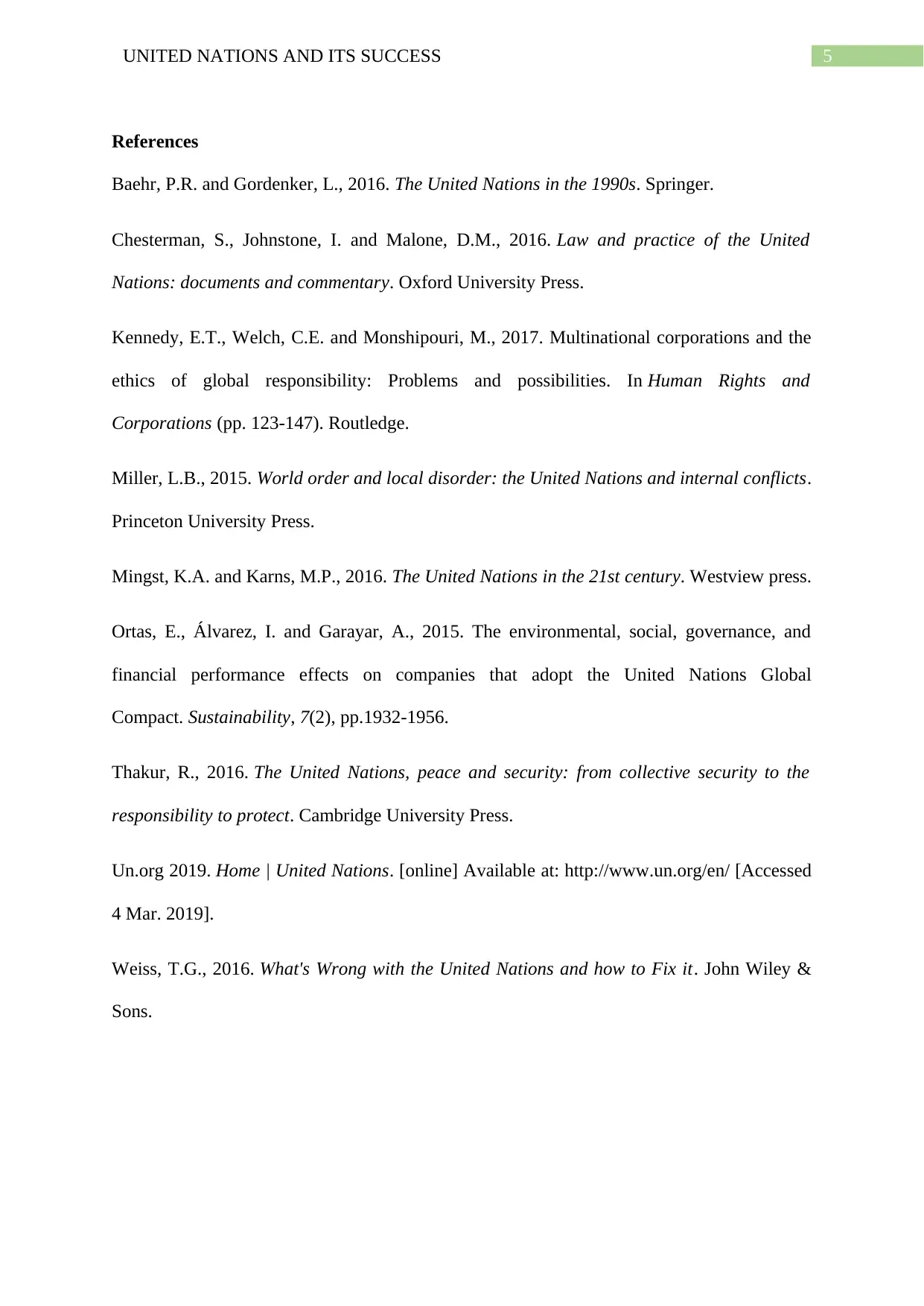
5UNITED NATIONS AND ITS SUCCESS
References
Baehr, P.R. and Gordenker, L., 2016. The United Nations in the 1990s. Springer.
Chesterman, S., Johnstone, I. and Malone, D.M., 2016. Law and practice of the United
Nations: documents and commentary. Oxford University Press.
Kennedy, E.T., Welch, C.E. and Monshipouri, M., 2017. Multinational corporations and the
ethics of global responsibility: Problems and possibilities. In Human Rights and
Corporations (pp. 123-147). Routledge.
Miller, L.B., 2015. World order and local disorder: the United Nations and internal conflicts.
Princeton University Press.
Mingst, K.A. and Karns, M.P., 2016. The United Nations in the 21st century. Westview press.
Ortas, E., Álvarez, I. and Garayar, A., 2015. The environmental, social, governance, and
financial performance effects on companies that adopt the United Nations Global
Compact. Sustainability, 7(2), pp.1932-1956.
Thakur, R., 2016. The United Nations, peace and security: from collective security to the
responsibility to protect. Cambridge University Press.
Un.org 2019. Home | United Nations. [online] Available at: http://www.un.org/en/ [Accessed
4 Mar. 2019].
Weiss, T.G., 2016. What's Wrong with the United Nations and how to Fix it. John Wiley &
Sons.
References
Baehr, P.R. and Gordenker, L., 2016. The United Nations in the 1990s. Springer.
Chesterman, S., Johnstone, I. and Malone, D.M., 2016. Law and practice of the United
Nations: documents and commentary. Oxford University Press.
Kennedy, E.T., Welch, C.E. and Monshipouri, M., 2017. Multinational corporations and the
ethics of global responsibility: Problems and possibilities. In Human Rights and
Corporations (pp. 123-147). Routledge.
Miller, L.B., 2015. World order and local disorder: the United Nations and internal conflicts.
Princeton University Press.
Mingst, K.A. and Karns, M.P., 2016. The United Nations in the 21st century. Westview press.
Ortas, E., Álvarez, I. and Garayar, A., 2015. The environmental, social, governance, and
financial performance effects on companies that adopt the United Nations Global
Compact. Sustainability, 7(2), pp.1932-1956.
Thakur, R., 2016. The United Nations, peace and security: from collective security to the
responsibility to protect. Cambridge University Press.
Un.org 2019. Home | United Nations. [online] Available at: http://www.un.org/en/ [Accessed
4 Mar. 2019].
Weiss, T.G., 2016. What's Wrong with the United Nations and how to Fix it. John Wiley &
Sons.
⊘ This is a preview!⊘
Do you want full access?
Subscribe today to unlock all pages.

Trusted by 1+ million students worldwide
1 out of 6
Related Documents
Your All-in-One AI-Powered Toolkit for Academic Success.
+13062052269
info@desklib.com
Available 24*7 on WhatsApp / Email
![[object Object]](/_next/static/media/star-bottom.7253800d.svg)
Unlock your academic potential
Copyright © 2020–2025 A2Z Services. All Rights Reserved. Developed and managed by ZUCOL.





